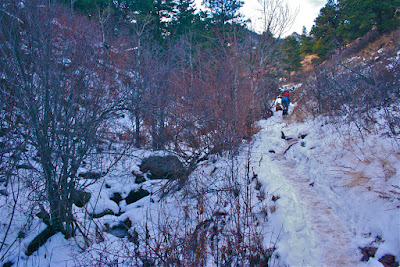Elevation: 10,030 ft to 10,630 ft or 11,061 ft
Elevation Gain: 600 ft (6 miles) or 1,031 ft (8 miles)
 Brittle Silver Mountain (12, 228ft). Note the mining ruin on the slope. This is the farthest I have gone up Peru Creek Road. Photo take in 2004. All other taken in December 2008.
Brittle Silver Mountain (12, 228ft). Note the mining ruin on the slope. This is the farthest I have gone up Peru Creek Road. Photo take in 2004. All other taken in December 2008.Peru Creek, near the Keystone Ski Resort, is a great novice or early season snowshoe. The elevation gain is relatively gradual and the route crosses several expansive valleys with incredible views. The eight-mile distance is more easily obtained on skis or for snowshoers who don’t have to drive up from Denver and return the same day. If you manage to make it that far, you will be rewarded with the additional attraction of the ruins of the Pennsylvania Mine.
 The first glimpse of Cooper Mountain (12,792 ft). Note the ski tracks to the right and the snowshoe track to the left. I love seeing fresh snow on the trees.
The first glimpse of Cooper Mountain (12,792 ft). Note the ski tracks to the right and the snowshoe track to the left. I love seeing fresh snow on the trees.There is a large, parking lot at the intersection of Montezuma Road and Peru Creek Road. It is usually plowed.
 First power line crossing. This is the most obvious one. The creek here is always snow covered. Somehow that does not look like a hot tub. You can actually see the power line on the topo map. It appears as a thin dashed line to the north of the road at is beginning. Here is where it crosses to the south.
First power line crossing. This is the most obvious one. The creek here is always snow covered. Somehow that does not look like a hot tub. You can actually see the power line on the topo map. It appears as a thin dashed line to the north of the road at is beginning. Here is where it crosses to the south.On snowshoes, it is a good half-hour to forty minutes before any of the spectacular views appear. Before this, there are glimpses of peaks through a mostly tree-shrouded road. At 0.5 miles Cooper Mountain (12, 782 ft) can be seen. Occasional glimpses to right of Morgan Peak (12, 474 ft) also occur. At 1.5 miles are the ruins of the Maid of Orleans mine. There are also two private cabins there, which can be rented out if you know the right person.
Just past the turn off to the Lenawee trail, which is clearly marked and often tracked, is the first valley. Here Morgan Peak and Brittle Silver Mountain on the right and Cooper Mountain on the left frame a winter tableau. If you go no farther than this, you will have been well rewarded. This valley is suitable for romping, trail blazing, and general fun in the snow. At the far end is a forest service road size point ahead to Argentine Peak and to the left to Chihuahua Gulch.
Beyond this first meadow, the trail winds upwards again through the trees. There is a short quarter mile segment that is very steep and narrow. On this trip, it was shortly beyond this meadow that we began breaking trail.
 A good view of Cooper Mountain. This small boulder field is always photogenic with its variable snow cap.
A good view of Cooper Mountain. This small boulder field is always photogenic with its variable snow cap. I like nothing more than being the first to track new snow but it is fatiguing and doing it on this steeper pitch made it doubly so. Still, with the thoughts of my Christmas over indulgences, I forged gamely ahead.
 Looking south. I believe this is Tip Top Peak (12,053 ft) which is west of Morgan Peak. Note the large avalanche chute down its side. From the size and lack of trees I would guess this chute sees action on a yearly basis.
Looking south. I believe this is Tip Top Peak (12,053 ft) which is west of Morgan Peak. Note the large avalanche chute down its side. From the size and lack of trees I would guess this chute sees action on a yearly basis.On this trip we stopped right at the beginning of the second valley. This was due to two things. First, our new German Short Haired Pointer was on her first snowshoe and she was shivering. Second, we had gotten caught in typical I-70 traffic and it had taken us 2 hours to get to the trailhead. It was therefore late in the afternoon and we were already fearful we would get trapped in the apres-ski stampede.

Eastern end of the first open valley.
Back in 2004 we went a little further so that we were almost abreast of Brittle Silver Mountain. From that point it was still around a mile to the Pennsylvania Mine. Given an overnight stay it would be an easily obtainable goal. I have always wanted to climb Argentine Pass and Peak, so perhaps this summer I will at least see the buildings.
If you are in Summit County or are daring the drive up from Denver, Peru Creek is a good choice. I have had friends complain to me that they find it too crowded and filled with snowmobiles. I have gone yearly now for the last four years and have not seen a single machine and usually the trail is sparsely populated and practically deserted after the first meadow. Others find the power lines that transect the valley a detriment to their outdoor experience. I find them easy to ignore, particularly since you cross their path only a couple of times. The views of the peaks are far more eye catching.














































